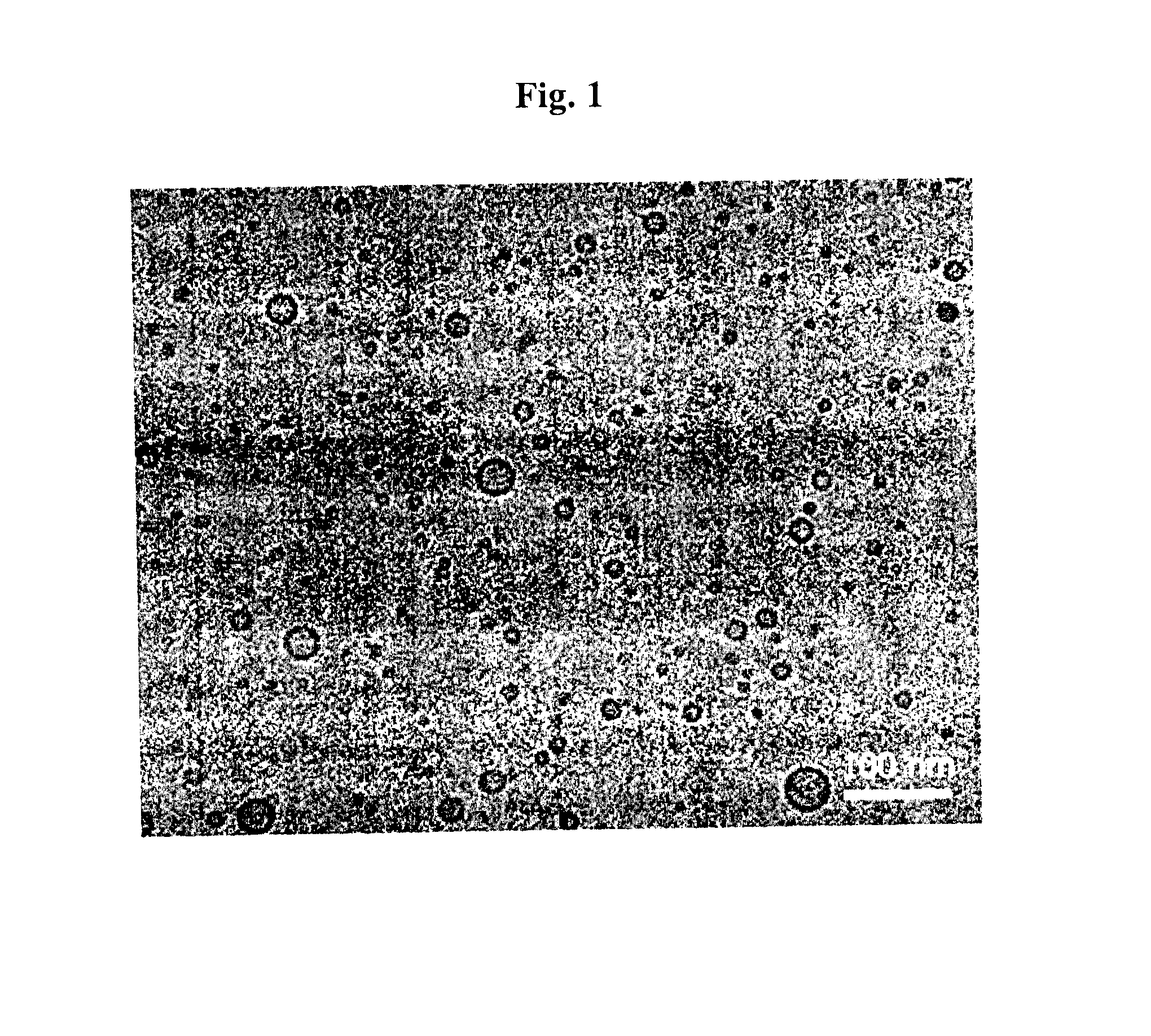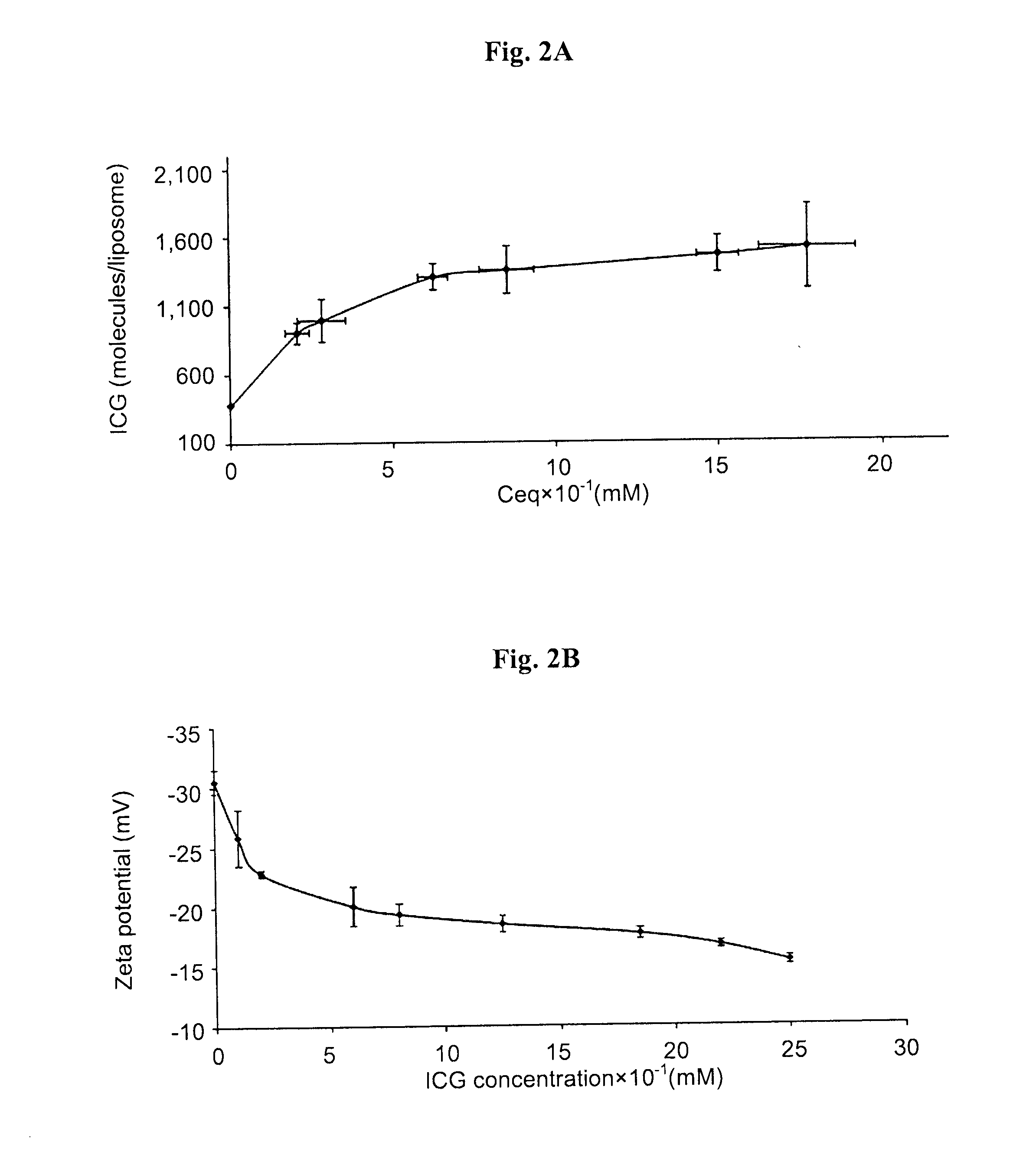Near infrared fluorescent particles and uses thereof
a fluorescent particle and near infrared technology, applied in the direction of powder delivery, peptides, drug compositions, etc., can solve the problems of increased cancer risk, difficult-to-treat diseases, common carcinomas,
- Summary
- Abstract
- Description
- Claims
- Application Information
AI Technical Summary
Benefits of technology
Problems solved by technology
Method used
Image
Examples
example 1
Preparation of ICG-Adsorbed Liposomes
[0171]Liposomes composed of Phospholipon 50 (Lipoid), permitted for oral delivery, were prepared by high-energy sonication, which typically leads to formation of small unilamellar liposomes. DLS measurements showed that the mean size (by volume) of the liposomes is 29.8±0.6 nm with a polydispersity index of 0.235-0.250, and zeta potential of −30.5±1 mV (at pH 7). Cryo-TEM imaging, shown in FIG. 1, confirmed that the liposomes are unilamellar in the size range of 20-40 nm, in agreement with DLS results.
[0172]The ICG binding experiments were performed by incubation of the liposomes with solutions of ICG at various concentrations. The adsorbed quantity of ICG was calculated by measuring the optical density of the solution obtained after filtration of the samples by a 300-kDa filter, which is expected to remove all the liposomes. The retained particles had a green color, giving a visual indication that the ICG is bound to the liposomes.
[0173]As shown...
example 2
Fluorescence of the ICG-Adsorbed Liposomes
[0174]The fluorescence spectra of the ICG-adsorbed liposomes prepared in Example 1 were evaluated in comparison to those of ICG in aqueous solution. It should be noted that because of a red shift that occurs in the systems containing the liposomes, as discussed hereinbelow, the emission intensities will be presented at the wavelengths in which the maximum of the peak was observed. FIG. 3A shows the fluorescence intensities of ICG solutions and for ICG bound to liposomes. As shown, the fluorescence intensity increases with the increase of ICG concentration, reaches a maximum at 6.4×10−3 mM, and is followed by a gradual decrease. The concentration at which the maximum is observed is close to that previously reported (Saxena et al., 2003) (2.6×10−3 mM) for ICG in aqueous solution. It is clearly seen that the fluorescence intensity is greater for liposomal ICG throughout nearly the entire concentration range studied.
[0175]The decrease in fluores...
example 3
Stability of ICG-Adsorbed Liposomes in Human Colon Fluid
[0179]The stability of the ICG-adsorbed liposomes (nanoprobes) in physiological conditions was tested by incubating the nanoparticles in human colon fluid for 7 hrs. As found by fluorescence measurements, although the ICG is not covalently bound to the liposome, it remained bound to the liposomes during at least 7 hrs, as shown in FIG. 5, indicating that the nanoprobes did not disintegrate in the colon fluid.
PUM
| Property | Measurement | Unit |
|---|---|---|
| diameter | aaaaa | aaaaa |
| diameter | aaaaa | aaaaa |
| volume-weighted mean particle size diameter | aaaaa | aaaaa |
Abstract
Description
Claims
Application Information
 Login to View More
Login to View More - R&D
- Intellectual Property
- Life Sciences
- Materials
- Tech Scout
- Unparalleled Data Quality
- Higher Quality Content
- 60% Fewer Hallucinations
Browse by: Latest US Patents, China's latest patents, Technical Efficacy Thesaurus, Application Domain, Technology Topic, Popular Technical Reports.
© 2025 PatSnap. All rights reserved.Legal|Privacy policy|Modern Slavery Act Transparency Statement|Sitemap|About US| Contact US: help@patsnap.com



